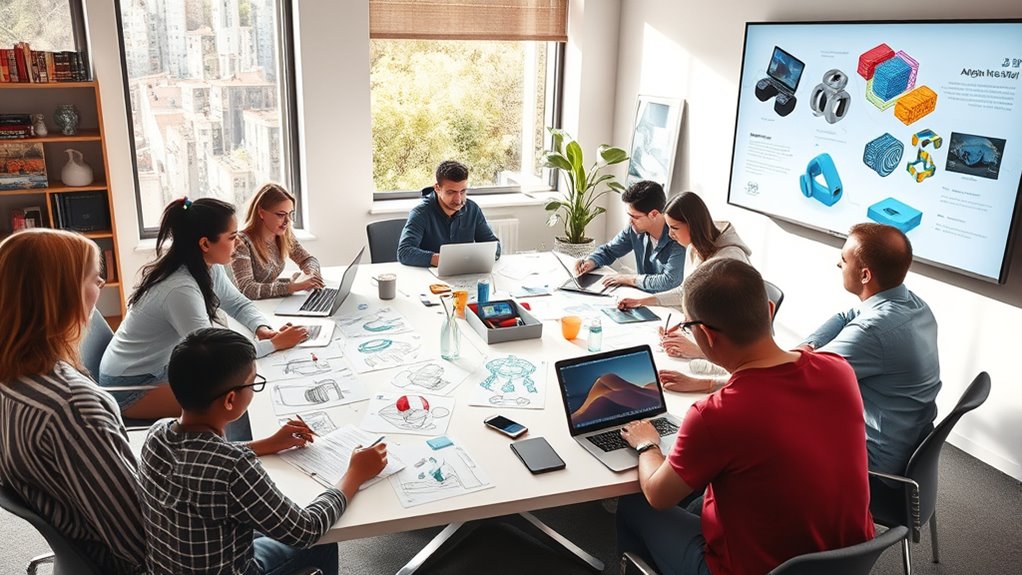AI enhances your creative process by providing data-driven insights, generating diverse ideas quickly, and helping you explore new design possibilities. It works alongside your intuition and emotional understanding, validating concepts and suggesting innovative approaches. This collaboration allows you to focus on high-level decisions while AI handles routine tasks and offers fresh perspectives. As AI tools continue evolving, you’ll discover even more ways to push your creative boundaries—exploring the future of collaborative design.
Key Takeaways
- AI analyzes large data sets to generate diverse ideas, expanding creative possibilities beyond human limitations.
- Human-AI collaboration combines intuition with computational insights, refining concepts efficiently.
- AI accelerates brainstorming by suggesting innovative variations and alternative approaches.
- Using AI as a creative partner fosters a mindset of continuous learning and boundary-pushing innovation.
- Technological advancements in AI streamline workflows, enabling the development of unique, trend-setting designs.

Have you ever wondered how innovative ideas come to life faster and more effectively? The secret often lies in the power of AI-driven ideation combined with human expertise. When you leverage AI tools in the design process, you’re not replacing your creativity; you’re amplifying it. This synergy between humans and artificial intelligence creates a dynamic environment where ideas evolve rapidly, and solutions become more refined. AI can analyze vast amounts of data, recognize patterns, and suggest possibilities that might take you days or weeks to uncover on your own. By integrating these insights into your creative workflow, you can generate more diverse ideas and iterate quickly, pushing boundaries you might not have explored otherwise.
AI-driven collaboration accelerates innovation by amplifying human creativity and refining ideas rapidly.
The true strength of collaborative design emerges from human AI synergy. You bring intuition, emotional understanding, and contextual knowledge to the table, while AI offers computational power and data-driven perspectives. As you work alongside AI systems, you can validate concepts in real-time, identify potential flaws early, and explore alternative approaches without wasting time on dead ends. This partnership allows you to focus on high-level creative decision-making, while AI handles the heavy lifting of analysis and ideation. It’s not about AI replacing your role but augmenting your capabilities so you can be more innovative and efficient.
With AI-driven ideation, your brainstorming sessions transform into more productive endeavors. Instead of starting from scratch, you can input initial ideas and let AI expand on them, suggest variations, or propose entirely new concepts based on current trends and historical data. This collaborative process sparks inspiration and accelerates the development process. Over time, you learn to interpret AI suggestions critically, blending machine insights with your creative instincts to craft unique solutions. The seamless interaction between human ingenuity and AI’s analytical prowess *unlocks* new levels of productivity and originality.
Furthermore, this collaboration encourages a mindset shift, where you see AI not as a tool but as a creative partner. Together, you break free from traditional constraints, exploring innovative design solutions that might have been out of reach before. The integration of AI-driven ideation into your workflow fosters continuous learning and adaptation, ensuring your designs stay ahead of the curve. *In essence*, by nurturing human AI synergy, you harness the full potential of collaborative design—creating smarter, faster, and more inspired innovations that elevate your work to new heights.
Additionally, advancements in AI technology, such as generative AI, play a crucial role in expanding creative possibilities and streamlining the design process.
Frequently Asked Questions
How Does AI Adapt to Different Human Design Styles?
AI adapts to your design style through personalization strategies and style recognition. It analyzes your past projects, preferences, and patterns to understand your unique approach. Then, it suggests ideas and modifications aligned with your style, making your creative process more efficient. By continuously learning from your input, AI fine-tunes its responses, ensuring that every suggestion feels tailored specifically to your individual design style.
Can AI Replace Human Creativity in Collaborative Projects?
AI can’t fully replace human creativity because it’s limited by AI bias and creative boundaries. While AI can generate innovative ideas and streamline processes, it lacks the emotional insight and intuition humans bring to collaboration. Your unique experiences and perspectives drive originality. AI acts as a tool to enhance, not replace, your creative process, helping you push boundaries and explore new horizons in collaborative projects.
What Ethical Considerations Arise From Ai-Assisted Design?
You should consider ethical issues like bias mitigation and data privacy when using AI-assisted design. AI can inadvertently perpetuate biases if not properly managed, so you need to ensure fairness and transparency. Additionally, safeguarding data privacy is essential to prevent misuse of sensitive information. By actively addressing these concerns, you help create responsible, ethical designs that respect user rights and promote trust in AI-driven collaboration.
How Do Designers Ensure AI Suggestions Align With Their Vision?
You can verify AI suggestions align with your vision by critically evaluating each idea for design consistency and how well it complements your creative intuition. Trust your instincts to refine or reject suggestions that don’t resonate. Investigate the AI’s reasoning when possible, and fine-tune its input parameters. This way, you maintain control over your creative process while harnessing AI’s potential to inspire and enhance your unique design vision.
What Skills Are Essential for Humans Working With AI in Design?
You need intuitive empathy to understand and interpret AI suggestions effectively, ensuring they align with your creative vision. Technical adaptability is also essential, as it allows you to quickly learn new tools and modify AI outputs to suit your project. By combining these skills, you can seamlessly collaborate with AI, leveraging its capabilities to enhance your creativity and produce innovative, well-aligned designs.
Conclusion
As you harness AI’s power in collaborative design, you find yourself balancing innovation with intuition. It’s like working alongside a creative partner who never tires, yet still relies on your unique human touch. While algorithms generate possibilities, your vision shapes the final masterpiece. Embrace this synergy—where machine precision meets your imagination—and watch your ideas flourish in ways you never thought possible. Together, you and AI redefine what’s creatively achievable.









